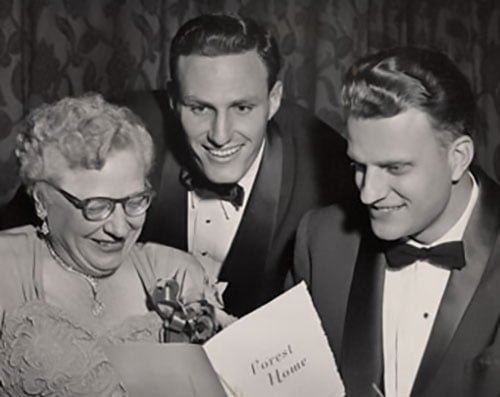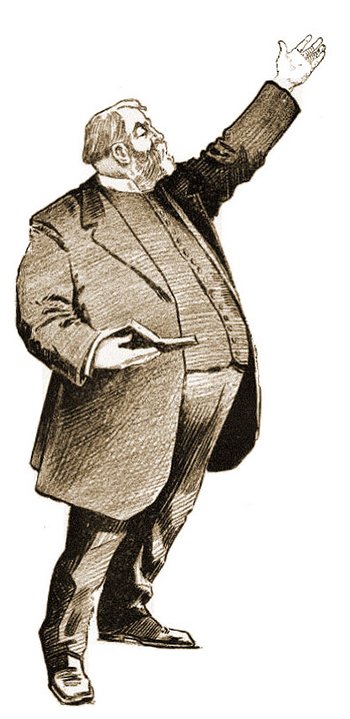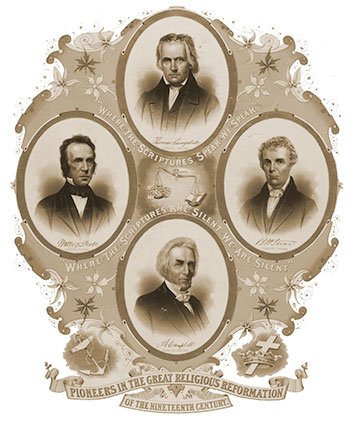Postwar (1945) Revivals

Billy Graham preaching in London’s Trafalgar Square
There is sufficient documentary evidence to conclude that there was a widespread and significant revival movement during the post-war period. Undoubtedly, each of the separate revivings fuelled the fires of the others as news travelled around the globe. Some occurred with a single individual. Others were amongst small gatherings and others had national impact.
God was clearly using the moment. On the one hand there were great anxieties due to the recent world war which was the deadliest military conflict in history. Over 60 million people were killed. In addition there was the fear of communism, atomic warfare and an increasing moral decline. On the other hand there was a new optimism, a sense that the war was over and that a new era filled with hope was ahead. It was into this scenario that God began to move.
Darmstadt, Germany – March 1947
One of the early signs of revival occurred in Germany when the Evangelical Sisterhood of Mary was founded by Sister Basilea Schlink, a German theologian and intellectual, on March 30, 1947. It was a result of a revival amongst young people in Darmstadt. The Sisterhood is an ecumenical, Lutheran based, religious order which immediately began to emphasise repentance and personal revival.
Pasadena, California – May 1947
In May, 1947, two men and four other evangelical scholars met in downtown Chicago for a time of seeking God’s will concerning the feasibility of launching a new theological seminary. These men were Charles E. Fuller, a well-known radio evangelist and Harold Ockenga, pastor of the Park Street Church in Boston. So strong was the spirit of prayer that the participants were convinced that God was indeed leading them into this venture of faith and Fuller Theological Seminary was launched. 39 students enrolled in the first entering class in the fall of 1947. Charter members of the faculty were Drs. Everett F. Harrison, Carl F. H. Henry, Harold Lindsell and Wilbur M. Smith. Their heart was to begin a new evangelical theological seminary to reform fundamentalism from its separatist and sometimes anti-intellectual stance of the 1920-40 era.
Southern California – June 1947
Henrietta Cornelia Mears (October 23, 1890 – March 19, 1963) was a Christian educator and author who had a major impact on evangelical Christianity in the 20th century. She was Christian Education Director of First Presbyterian Church of Hollywood, California. Literally hundreds of men and women went through her Sunday school program into full-time Christian service.
She founded Forest Home, a Christian conference centre in the San Bernadino Mountains in Southern California where, in June 1947, she held the Forest Home Conference. In her audience were Rev. Richard C. Halverston, assistant pastor of the Hollywood Presbyterian Church and Bill Bright, a new Christian who later became the founder of Campus Crusade for Christ. She spoke about the communist threat and referred to the courageous ‘expendables’ who were soldiers of outstanding courage who were employed in the most difficult assignments. Her plea was for Christian ‘expendables’ for Christ, a greater commitment to prayer and scriptural faithfulness, as well as revival.
That night the two men, with several others, prayed late into the night. They were overcome with a sense of hopelessness and inadequacy. There was confession of sin, seeking God for guidance and for the power of the Holy Spirit. Suddenly, the fire fell and a new vision was born in their hearts for students in college campuses across the world. They believed they should start with America and invite hundreds of students to a new ‘briefing’ like soldiers being briefed before their missions.

Henrietta Mears and Billy Graham
With Henrietta Mears, a zealous army wrote letters, travelled, telephoned, prayed, addressed churches, talked to pastors, and planned the meetings. In Santa Cruz the Spirit of God fell in a deputation meeting and hundreds of the thousand present went forward to dedicate their lives as ‘expendables’ for Christ.
The briefing in August, 1947 attracted six hundred students from all over the States. Miss Mears spoke about sin, confession, forgiveness, cleansing and the Holy Spirit. Throughout the conference conviction and confession of sin continued, some became Christians and several volunteered for mission work. The entire student body left with a fresh passion to win their own colleges for Christ. Thereafter, the ‘Briefings’ became an annual event.
Hollywood film stars began to get converted. Edwin Orr, a young Irish evangelist, offered helpful input at the Forest Home Conferences and became the acting pastor of the Hollywood Christian Group. Scores of actors, cameramen and technicians found Christ in Miss Mears’ living room.
Billy Graham, though little-known at that time, was invited to speak at the morning meeting of the 1949 College briefing and Edwin Orr took the evenings. They prayed together for complete surrender and the filling of the Holy Spirit. That night Graham sought God and reported to Orr that he had been filled with the Spirit and that something unusual was going to happen in Los Angeles. How right he was! This was a turning point in his ministry. His Los Angeles crusade was an astounding success and the wildfire publicity he received thrust him into one of the greatest evangelistic ministries of all time.
US College Awakenings 1949-1950
Edwin Orr has written extensively on college awakenings that occurred between 1949-1950 in the more general ‘Campus Aflame’ and ‘Good News in Bad Times.’ He recorded significant revivals in over a dozen colleges across the States. The most notable was at Wheaton College where for 4-5 days from February 8th 1950 there was an unusual sense of God’s holiness with a deep conviction of sin. One after another students took to the platform and publically confessed their sins and either their commitment or re-commitment to Christ. One meeting lasted 42 hours! The event was reported in the local and national press as well as in Time magazine. (The Time report can be read here.)
Interestingly Edwin Orr had conducted a course on Spiritual Awakenings at Wheaton over the summer of 1949 and the meetings were preceded by a day of prayer on the 7th February to ask God to ‘open the windows of heaven and pour out a blessing.’ He did.
Lee College in Cleveland, Tennessee saw a similar move of God in February 12-19th, 1950. On this occasion the usual manifestations of conviction and confession were experienced but gifts of the Holy Spirit were also poured out upon students and faculty members alike.
Asbury College in Wilmore, Kentucky enjoyed a wave of God’s glory from February 3rd 1950, firstly as a holy hush, then a wave of power which swept over the hungry students who were drawn there by the spiritual magnet. There were tears and laughter as the crowds assembled and surrendered to Christ. The meeting continued through to March 1st.
The emergence of major evangelists
It was in this era between 1949-1952 that major evangelists began to have extraordinary success. Billy Graham was catapulted to national fame after his Los Angeles campaign in October 1949. Further meeting’s through 1950 gathered massive crowds and the conversions were regularly in their thousands at the crusades. There had not been such evangelistic success since the days of George Whitefield preaching in the Great Awakening.
The Canadian, Charles Templeton also had extraordinary success in the early fifties with thousands attending his meetings and countless converts. However his triumphs were only short-lived as he left the faith and never preached again after a few years.
The British evangelists, Tom Rees and Bryan Green, also held their own large evangelistic meetings in on both sides of the Atlantic in the late forties and fifties with unusual results.
The Hebrides Revival
In late 1949 the Islands of Lewis and Harris were the scenes of powerful awakenings through the ministry of Duncan Campbell. From its beginning in Barvas the whole island was touched by the awesome presence of God and awakened to eternal realities. The revival was peppered with trances, prostrations, groans of distress, cries for mercy and prayers of repentance. For many across the world the Hebrides revival ignited fresh faith for God to move in power as he had done before. Go here for Duncan Campbell’s two reports of the Hebrides revival – one – two
Korea
In 1947 the persecuted church sought God for an outpouring of the Spirit like they had experienced a generation before. When the visitation came in 1950 there were 25,000 converts in the first six weeks! Tears, confessions and cries for mercy were common. Signs and wonders broke out as the sick were healed and authenticated by Western missionaries. At first they were sceptical, but they could not deny the evidence of their own eyes. Early-morning prayer and all-night prayer meetings became the norm for thousands of believers and God continued to reap an astounding harvest of souls.
Other fields
Space does not permit further reports but there is documented evidence of revivals occurring in Vietnam, Czechoslovakia, Portugal, Mexico, Puerto Rico, Brazil, South Africa and other places, during the same period that the Healing revival was enjoying its heyday. The context in which the Healing Revival occurred was one of international awakening when God was arousing His church and preparing them for the next great advance of His Kingdom on earth.
Bibliography: Richard Riss, Latter Rain (1987); J. Edwin Orr, Campus Aflame (1971), Good News in Bad Times ((1953); Ethel May Baldwin & David V. Benson, Henrietta Mears and How She Did It (1966)
Tony Cauchi



